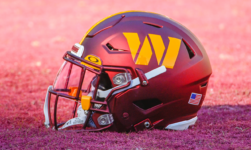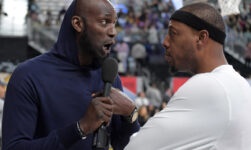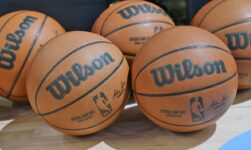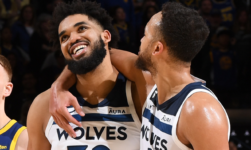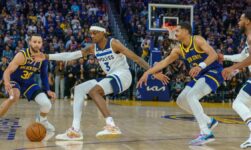With pretty much every team in the NBA at or past the 20-game mark, we’ll call this the quarter-pole point of the season. Still early, yes. But we’ve seen enough to at least start some worthwhile conversations. Below are the most noteworthy storylines thus far in the 2021-22 season.
This will not include anything about Ben Simmons’ ongoing drama in Philadelphia, because nothing has developed there. Simmons doesn’t want to play for the Sixers, who in turn aren’t going to trade him for the scraps they’ve been offered. We’re still in the same place we were prior to the season.
Please check the opt-in box to acknowledge that you would like to subscribe.
Thanks for signing up!
Keep an eye on your inbox.
Sorry!
There was an error processing your subscription.
Same with John Wall not playing in Houston. He’s healthy, he’s ready to play, but the Rockets now reportedly want him to come off the bench, which Wall apparently isn’t keen on doing. So he continues to sit. Which is fine by the Rockets, who in the absence of a trade clearly have no real interest in putting potentially their best player on the floor for fear of actually winning a few games.
With that in mind, below are five teams/players that, to me, represent the biggest stories thus far. It should be noted that I recognize the Washington Wizards — 13-7 entering Monday — deserve to be on this list, but the truth is I haven’t watched them play enough to credibly comment beyond their record.
1. Warriors back out to play
There was certainly optimism surrounding Golden State entering the season, but an 18-2 record with the league’s No. 1 defense, No. 2 offense and top point differential by a mile? Stephen Curry is on pace to break his own single-season 3-point record and sits as the clear early MVP favorite. Draymond Green is in the DPOY mix.
Andrew Wiggins, trailing only Green in ownership over Golden State’s defensive dominance, has been superb, particularly of late: 22 points per game on 55 percent shooting, including 41.5 percent from 3, over his last 10.
Jordan Poole is a part-time flame-thrower and full-time threat. Gary Payton II is must-see TV. Nemanja Bjelica might be one of the more impactful marginal signings in the league, spacing Golden State’s flowing-water attack; Payton’s growing number of cuts for dunks happen almost exclusively with Bjelica on the floor. Otto Porter Jr. is shooting 43 percent from deep. Kevon Looney is quietly integral.
With shooters and versatile defenders everywhere, all the Golden State pieces fit. The ball is moving. Depth is again a strength. The pace is relentless. The easy-schedule qualifier was somewhat squashed with blowout wins over the Bulls, Nets and the surprisingly stout Clippers on Sunday. With Klay Thompson nearing his return, it’s starting to feel like the good-old days in the Bay.
2. Lakers’ Westbrook gamble not paying off
Russell Westbrook is far from the only issue with the 11-11 Los Angeles Lakers, but he’s at the core of their bottom-10 3-point shooting and doormat point-of-attack defense. There is little debate that the Lakers, at least at present, would be a better team with Montrezl Harrell, Kentavious Caldwell-Pope and Kyle Kuzma (the latter two their best perimeter defenders from a year ago), all of whom they traded for Russ. They would almost certainly be a better team with sharpshooting Buddy Hield, whom they reportedly could’ve landed for a Kuzma-centric package before getting drunk on the idea of adding Westbrook’s name to their masthead.
Point is, the Lakers, rather recklessly, went all-in on Westbrook, and so far the move has predictably backfired. I say predictably, of course, because it’s not like Westbrook just turned into a terrible shooter over the summer. Lakers GM Rob Pelinka had the same information everyone else in the world has had for years with regard to Westbrook’s brick-laying ways; just as Pelinka was, or at least should’ve been, privy to Russ’ warranted reputation as a turnover factory, half-court space sucker and replacement-level defender.
The gamble could only pay off if Westbrook, while playing with LeBron James, ditched his pull-up preoccupations and attacked the rim, as he did with the Rockets in the second half of 2018-19. Little problem: The Rockets reshaped their entire team to give Westbrook a wide-open lane, shipping Clint Capela to Atlanta so they could go five out with P.J. Tucker at center. Frank Vogel ain’t going that way. He’s gone with two-big lineups to a maddening degree, and even when the Lakers don’t play twin towers, Anthony Davis is going to be on the court.
Plus, throw out Carmelo Anthony, and the Lakers aren’t scaring anyone with their shooting, especially if they want to field defensively competent lineups. LeBron is shooting more 3s than ever, and defenses will be happy to let that continue. Westbrook is going to fight cramped lanes all season, and that pull-up jumper is going to become increasingly attractive by default.
The other way the Westbrook gamble could’ve worked, particularly in the regular season, is with him carrying non-LeBron lineups as a pick-and-roll parter with Davis. Instead, entering Sunday, the Lakers were getting roasted by 6.8 points per 100 possessions, per Cleaning The Glass, with Westbrook and Davis operating sans the King. It doesn’t help that Davis fired about as many blank jumpers as Westbrook this season.
Westbrook isn’t getting traded. Nobody wants his contract, or, frankly, his game at this point. There’s too much evidence that he’s a negative player, Pelinka’s wish-upon-a-fallen-star offseason strategy be damned. All the Lakers can do is possibly mitigate his many minuses by playing fast and small as often as possible, and it feels like even that can only go so far.
In the end, the Lakers just might not be that good. Yes, LeBron has missed time, but even when he’s healthy he might not be quite the same player we’ve long expected to carry even flawed teams into contention. On Sunday, the Lakers got about as good a game out of their Big 3 as they can realistically hope for — a combined 82 points on a collective 63 percent shooting for LeBron, Davis and Westbrook, and still they could only manage to beat the Pistons by four to crawl back to .500.
3. DeMar you watch, da better da Bulls look
The Chicago Bulls have lost three of four, including a disastrous defeat at the hands of the hapless Rockets, to scratch up some of their early-season shine, but we’re still talking about an infectiously fun team with the league’s sixth-best point differential.
DeMar DeRozan is making MVP waves. His 25.8 points a night ranks seventh league-wide, and nobody has scored more points in the fourth quarter; he’s shooting a flat bonkers 67.2 percent on clutch shots, as defined by Inpredictable. DeRozan is an isolation monster, 95th percentile per Synergy, serving as Chicago’s main half-court pipeline for crunch-time offense. The Bulls are over 22 points per 100 possessions better with DeRozan on the court, per CTG. He’s been nothing short of spectacular.
He’s hardly alone. Zach LaVine might be the smoothest scorer in the world, and that’s not an exaggeration. He can create a shot out of absolutely nothing with his ability to spring full force into vertical space and shoot all manner of fadeaways with a flick of his wrist. This means the Bulls are almost never stuck for a bad shot if he’s on the court, even when defenses stymie their actions for much of the possession; in the last four seconds of the shot clock, LaVine’s 47 total points — on 61 percent shooting including 47 percent from 3 — leads the league.
As if they’ve played together for years, LaVine has settled into a natural your-turn-my-turn relationship with DeRozan, with whom he shares much of the crunch-time responsibility; LaVine is shooting a Kevin Durant-like 62 percent on clutch shots, per Inpredictable, and his 40 total clutch points is tied for second-most in the league. LaVine is also a cheetah in the open court, where Chicago is the league’s most efficient team at 135 points per transition possession, per CTG.
You can’t run like that without getting stops, and this is the source of Chicago’s greatest surprise. Entering Monday, they’re the No. 5 defense in the league, and upon securing defensive rebounds, the Bulls need only an average of 10.7 seconds to race back the other way and attempt their own shot, the fastest turnaround time in the league.
Lonzo Ball — who oh by the way is shooting 43 percent from 3 — and Alex Caruso are Chicago’s DeRozan-LaVine on defense, a tag team of relentless on-ball and passing-lane activity. Ball is 10th in steals and has evolved from a roving helper to a point-of-attack menace. Caruso is second in the league in steals per game and total deflections. If the season were to end today, Caruso should be first-team All-Defense, and Ball isn’t far behind. The Bulls are outscoring opponents by just under 11 points per 100 with Ball and Caruso on the court, per CTG.
The Bulls have done all this with Patrick Williams, who was supposed to be their best defender, likely out for the season after playing just five games and Nikola Vucevic shooting like he’s blindfolded. The latter likely won’t continue, though Vucevic’s drop coverage is a potential problem come playoff time. Are the Bulls as good as they’ve looked through the first quarter of the season? Perhaps not. Are they worlds better, particularly on the defensive end, than most anyone expected? Absolutely.
4. So much for a Suns regression
After losing three of their first four, the Phoenix Suns have rattled off 16 straight wins heading into their showdown with Golden State on Tuesday. Talk of Chris Paul’s decline is overstated. Yes, he’s averaging a career-low 14.5 points per game, but his 10.1 assists per game lead the league. He basically never gets to the rim, but that’s been true for a while, and he remains a midrange monster and master of the clutch minutes.
When games are within five points with five or fewer minutes to play, Paul is shooting 66 percent from the field; his 1.1 assists per clutch outing lead the league and his 29 total points ranks top 10.
Devin Booker, a chip off Paul’s slithering pick-and-roll block, continues to develop as a playmaker while shooting a career-best 42 percent from 3, per CTG, and he’s even more lethal in money time than Paul: 73 percent from the field, 60 percent from 3 and eighth in total clutch points (30). No wonder the Suns have come out 5-1 in games decided by five points or less.
Meanwhile, with Ben Simmons inactive, Mikal Bridges is the best perimeter defender in the league and it’s not really debatable right now. That he’s shooting 40 percent from 3 and capably putting the ball on the floor on second-side actions, ball swings and against closeouts makes him arguably the most valuable non-alpha wing in the league. Entering Monday, the Suns are 16 points better per 100 with Bridges on the court, per CTG, and the bulk of that team-best statistical boon resides on the offensive ledger.
It’s not just Bridges who buckles down. It’s everyone. Phoenix ranks third defensively because you can’t find a real hole anywhere. The Suns are a string of interchangeable parts along the perimeter that limits 3-point attempts, notably from the corner. and Deandre Ayton protects the backside.
That’s not to say Ayton is an elite rim protector, but he’s super mobile and athletic and, like a good shooter who doesn’t have great percentages at the moment, he represents a greater threat than the 63 percent teams are shooting at the rim against the Suns, per CTG. Teams take note of his presence. Plus, Phoenix is so good on the perimeter that teams only get to the rim for 30 percent of their shots, which is just outside a top-10 mark, per CTG. Only five teams are forcing opponents into more midrange jumpers than the Suns.
After their surprise run to the Finals last season, the Suns were a popular pick to come back to earth this season. That hasn’t been the case. Along with Golden State, they have established themselves in the early going as one of the two best teams in the league and once again a legit championship contender.
5. Nets traveling a hard(en) path
James Harden’s play was starting to pick up; now he’s 7 for his last 30 from 3 and shooting 31 percent from the field over his last four games. First his hamstring wasn’t healthy. Now he says he’s struggling to strike a balance between pursuing his own offense and setting his teammates up.
He might have a point. When Harden is on the court without Kevin Durant, which allows him to flip the selfish switch without the guilt of stealing shots from arguably the greatest scorer ever, the Nets are outscoring opponents by 11.5 points per 100 possessions, per CTG. On the flip side, when Durant plays without Harden, Brooklyn is bludgeoning teams by 29.5 points per 100.
Problem is, when Harden and Durant play together, the Nets are barely a positive team. That’s somewhat misleading; small-sample lineups are adding up to some horrific numbers, Joe Harris has been out, and at the end of the day the Nets are 14-6 and the East’s No. 1 seed entering play on Monday. But now Harris is having ankle surgery and is out four-to-eight more weeks, at least.
All the while, a dark reality exists: Harden, so far, is simply not the same kind of superstar threat when he’s not on a never-ending march to the charity stripe. Nearly every one of Harden’s big scoring games this season have come with double-digit free throws, and that’s not coming to fruition often.
Throw out last season when he was basically a no-show in Houston before playing less than half a season with the Nets, and the last time Harden averaged fewer than 10 free throws per game was 2013-14. This year he’s averaging under seven, and even that number is propped up by a handful of 15-plus-attempt games.
Harden has never been an elite shooter from an accuracy standpoint; he just pumped enough shots to overwhelm the box score. So far this year, he’s shooting 40 percent from the field and his pretty typical 36 percent from 3. It’s a different ballgame when you can’t trick your way into free points and have to actually make shots.
Harden is still a great player, and again, he’s looking more like himself of late in terms of gaining leverage off the dribble. But without Kyrie Irving, is a better-but-still-not-elite Harden enough to give Kevin Durant a fighting chance at a third championship? My guess is yes, but no way can they be considered a favorite. Durant has been positively spectacular, but the defensive harassment he faces will likely, eventually, get just enough of him to wear the Nets out unless Harden turns back the clock or Kyrie gets the jab.
Honorable mentions
Wizards mania: Like I said, I just haven’t watched them play enough to credibly comment. But 13-7 and No. 3 in the East? If you saw that coming, easy schedule or not, you need to start playing futures in Vegas.
Sixers get A for effort: The record has fallen off amid Joel Embiid’s extended COVID absence, but this team has done everything in its power to compete with the hand it’s been dealt. Tyrese Maxey, who looks like a near-future All-Star, is a jolt to Philadelphia’s typically plodding half-court pace; he has to attack the same way with Embiid back in the fold. Seth Curry was stuck on automatic in the early going but was always overstretched as a primary option. Miles Bridges: His leap has been staggering. He should be at the front of everyone’s Most Improved Player conversation.
Nikola Jokic is better: Better than he was last season, that is, when he ran away with the MVP. But we knew Denver would struggle to compete without Jamal Murray and certainly once Michael Porter Jr. went down.
Luka or bust: This remains Dallas’ blueprint if Jason Kidd doesn’t go too far in trying to spread the wealth as Doncic watches inferior creators get their turn (and enough of the post-ups already). Kristaps Porzingis’ recent play does hint at higher hopes.
Neil Olshey newsflash: The Blazers, indeed, have a roster problem. They have no chance guarding at the point of attack, and as a result they are in constant scramble mode. Over-helping is an epidemic; they’re surrendering open 3 after open 3, particularly from the corner. Who could’ve possibly predicted a teeny-tiny three-guard core led by career red-carpet defenders in Lillard and McCollum struggling to defend? Robert Covington’s not the help he was supposed to be in name. Larry Nance and Nassir Little provide hope in non-Nurkic lineups (plus-6.7 per 100, per CTG) but can only do so much.
Atlanta better than record: I’m not worried about the Hawks, who maybe weren’t quite as good as their conference finals run last season suggested but in the end remain a dangerous playoff team with Trae Young pulling the levers. Like everyone, I am curious whether GM Travis Schlenk makes a move to consolidate his stable of young wings into a more premium player.
Boston Me Party: Jayson Tatum is obsessed with isolating. He’s obviously capable of scoring on anyone, but his shooting numbers in such possessions are hard to look at. Chilling on the 10-dribble contested pull-up mid-rangers wouldn’t be the worst idea in the world.
Heat Culture alive and well: Miami is better with Kyle Lowry. It’s shocking, I know. And color me completely unsurprised by Tyler Herro being awesome.
The Cavs are a blast: Evan Mobley is a revelation, but he’s shelved for a while. Darius Garland is good. The two-big defense with Mobley and Jarrett Allen is refreshing in this day and age. But do not, under any circumstances, buy even one share of Ricky Rubio stock at this price.

